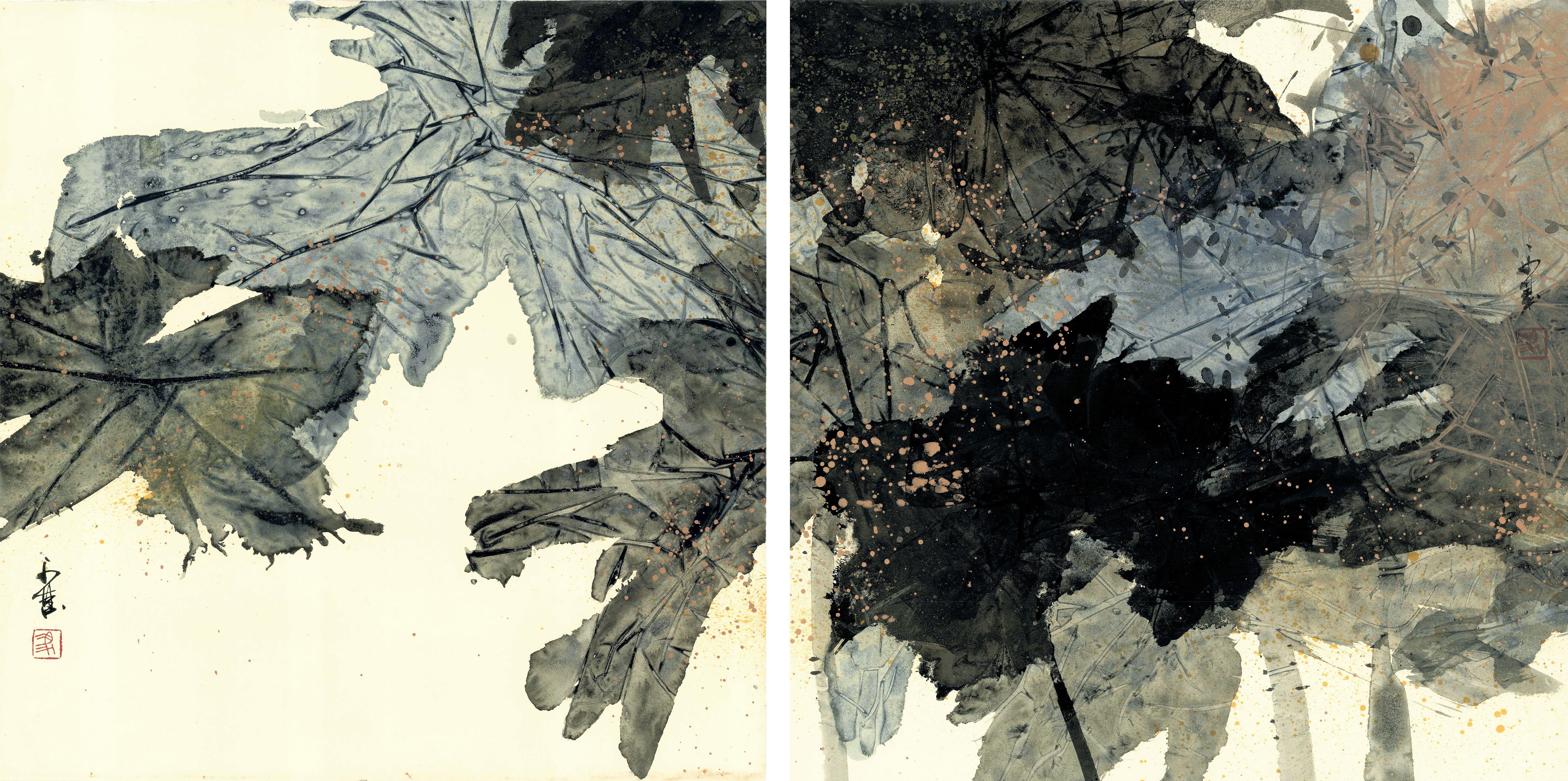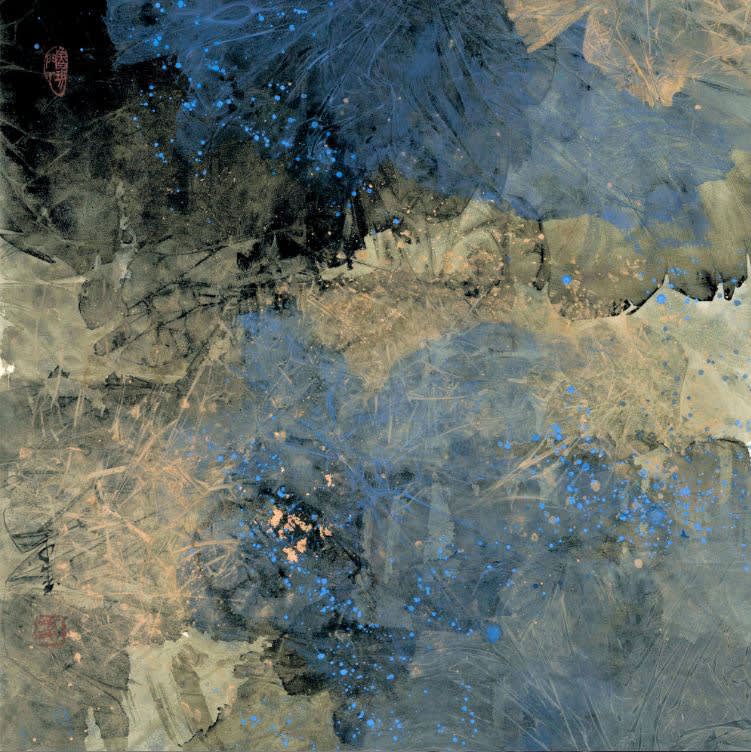
“As a local architect, I lacked the opportunity to go around the world to express my concerns for the Earth and humanity, but I believe I can achieve this as an ink artist."
- Raymond Fung
Raymond Fung created his new body of work, Life, to reflect on the global pandemic and express his understanding of humanity in crisis. To understand Fung’s humanistic approach in his works, one should look back along his life’s path. Fung grew up in Hong Kong but in 1973, he left his home city for the United States to major in architecture and art. Upon his return to Hong Kong he worked as an architect delivering commercial and government commissions, and later developed his connection with the US by participating in an exchange program at Pei Partnership Architecture, in New York.
When we talk about Fung today, we cannot ignore his identity as a “local architect”. His profound thoughts and awareness of the social issues surrounding the environment and human survival form his perspectives about the future of society. This knowledge has enriched the humanistic elements in Fung’s works.

Raymond Fung, Life (2)(3), 2020, Ink and colour on paper, 43 x 43cm (x2)
Fung’s multicultural experiences have manifested themselves in bold concepts and an inclusive approach to his painting expression. Since he was a child, Fung has studied painting from Lingnan painters, and his early works reveal traditional imprints, such as the stretching style and use of colour, from the Lingnan school. Inspired by the Hong Kong New Ink Movement, Fung found a turning point in the concept and cognition of modern ink art and began to develop his own abstract artistic language in 1980s. Although Fung's painting techniques capture the essence of various schools and painters, he has never completely immersed himself in the style of one specific school, and instead constantly challenges himself, innovating his own artistic language. Fung’s works combine Eastern traditions and the contemporary spirit of the West, whilst also incorporating materials and techniques from ancient and modern practices. In the 1990s, Fung’s style began to mature. He applied his eastern aesthetic to global issues such as the environmental crisis, and finally developed his own contemporary artistic language where his international vision and eastern spirit can be found.
“I think Chinese artists should broaden their subject matters in order to integrate Chinese art in the increasingly internationalised art scene as well as Hong Kong local culture, while maintaining its tradition."
- Raymond Fung
To transform Chinese contemporary art in keeping with itstraditions, creative methods should be developed that match the context. Drawing from his architectural background, Fung’s creative concept explores the human condition through two lenses. The first is that of survival and the artist’s reflection after years of observing Hong Kong's living environment and spatial structure. Fung maintains a sober perception and reflection on this. Whether it is his fascination with depicting the suburban landscapes of Hong Kong in his early years, or his later reflections on environmental pollution, the ecological crisis or the pandemic, his works constantly ring an alarm for human survival. Second, is his observation of space. With his architects eye and training, Raymond creates a visual harmony in the exhibition space. These two views intertwine and form a creative dialogue that respond to the surroundings and lifestyle.

Raymond Fung, Life (6),2020, Ink and colour on paper, 43 x 43cm
Life (2, 3, 4, 5) and Life (6, 7) make extensive use of the polyptych to create an undulating spatial rhythm. Fung compares his works to "window frames", and integrates his architectural knowledge into the ratio and spacing of the frames. Since ancient times windows have connected the ‘observer’ and the outside world. At the same time, Fung interprets the paintings as the aperture between the human race and heaven. These ‘apertures’ present his unified view of nature and history, and focus attention on the environment, historical distress and the destiny of humans.

Raymond Fung, Life (4)(5), 2020, Ink and colour on paper, 43 x 43cm (x2)
The Life series mainly focuses on plants and through these works, Fung explores the meaning of life for every creature including human, trying to find their origin in the ever-changing universe. In his paintings, flowing brushstrokes run through the papers and break through the frame whilst the strong visual contents also reflect the interaction and tension between Fung's pursuit of restraint and release.
In addition, the composition of the paintings reflects Fung's multiplicity of thought. In Life (2, 3, 4, 5), Fung used a composition in which the actual subjects of the painting are pushed to a corner or one side of the frame, leaving the other part of the painting more or less empty. The navy branches, leaves and broad brushstrokes form a strong contrast with the blank area. The thick brushworks reveal a desolate atmosphere and a sense of crisis. The blank areas in Life (5) leave a "breath" for the viewers and also simulates the "atrium" of buildings, which free up a unique, monologue-like private space that allows the viewer to relax. All of these spatial techniques form a unique aesthetic in Fung’s works.
Although the Life series was created during the pandemic, it is not necessary for usto associate them with this event in order to understand the artist's reflection on life. In Fung’s paintings, it is not difficult to see that the traces of ink are created by Fung’s contemplation of the energy around us. His brushstrokes echo with life, history and the universe, and discuss the environmental crisis and the survival of the human race.
Fung's philosophy on life has deepened in recent years with issues such as climate change and extreme weather. The pandemic has undoubtedly reminded Fung to review the relationship between humans and nature. Fung experimentally puts ink and paint onto a non- absorbent Japanese paper, then covers it with cling wrap. He then presses on the wrap with his hands, massaging the ink whilst it dries, creating fissures where the colours blend together. These cracked patterns create an abstract scenery, presenting the misty and shimmering tones, which not only express abstractness, but also the pursuit of Daoism and Buddhism. Fung’s training in architecture also enhanced his sensitivity in his use of colour, hence he tends to choose vivid and highly saturated colours, rather than adhering to the tone of traditional Chinese paintings. Such experimental use of ink and color is a rebellious attempt by Fung when returning to the tradition of ink art. Breathing is Fung’s furthest departure yet from the foundations of his formal training.

Raymond Fung, Life (1), 2021, Ink and colour on paper (Triptych), 180 x 105cm (total)
(Life (1) was sold for HKD 604,800 at Sotheby’s Hong Kong Autumn Sales in 2021.)
In Life (6)(7), the leaves are sparsely dotted with orange and fluorescent blue ink marks on their surface, interspersed with branch and vine like forms. Fung used the elegant brushworks found in ancient Song paintings here, adding abstract hints to the ecological environment. He attempts to convey the power of destiny and the unity of material and oneself. Life (1) uses various colours as Fung’s alert for the future crisis. From left to right, the painting is divided into three parts, which seems to be continuous and at the same time separated. Although the plants are drawn continuously across the three papers, the tones and depths of the joints are extremely different. As the cold blue tone fades, Fung added orange, yellow, purple, and other colors that are more commonly found in flowers. At the same time, Fung subtly reflects the chaos and natural connotations of Taoism, alongside the Zen of Buddhism through the scenery in his paintings, while expressing his feeling towards life and destiny. This wit and refinement that Fung conveys within the frame, arises from his insights into natural life, as well as awareness of the crises facing our time, and the great dangers facing the future of humanity and life.
The Breathing series was first released in 2020 with Fung reflecting on the relationship between humans and their natural ecology. The Life series created in the same period is derived from the same fundamental concept and humanistic perspective. The same techniques and materials were used. However, there are small differences between the two series. First of all, the Breathing series discusses the issue of environmental crisis and conservation from the perspective of man, bringing attention to the fact that we all have the responsibility to save our planet. On the other hand, in his depictions of animals and plants, the Life series focuses on the link between the two largest groups of organisms, namely animals (including human) and plants. Both series have their own iconic meanings. They mark Fung's ink art moving to a new stage, showing the artist's gradual and continuous in-depth construction of his perception of life. Fung once said: "My multicultural background allows my works to stand in the Western society and show the contemporary vision of Chinese ink artists to the world." The Life series serves as an example for the artist to extend the language of Chinese paintings, and bring ink art to another level. It continues to explore contemporary ink expressions that integrate nature, history and life, and introduce the viewer to reflect in the intertextuality of life and space.

